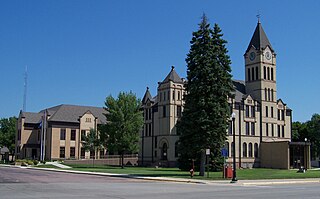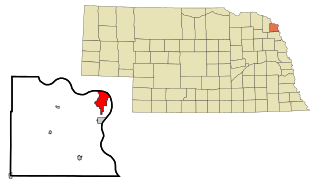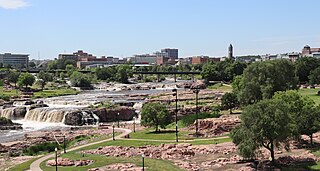Covington, Nebraska | |
|---|---|
| Coordinates: 42°29′N96°25′W / 42.49°N 96.41°W | |
| Country | |
| State | |
| County | Dakota |
Covington is a ghost town in Dakota County, Nebraska, United States. [1] It is now incorporated into South Sioux City, Nebraska.
Covington, Nebraska | |
|---|---|
| Coordinates: 42°29′N96°25′W / 42.49°N 96.41°W | |
| Country | |
| State | |
| County | Dakota |
Covington is a ghost town in Dakota County, Nebraska, United States. [1] It is now incorporated into South Sioux City, Nebraska.
A post office was established at Covington in 1858, and remained in operation until it was discontinued in 1893. [2] It took its name from the Covington, Columbus and Black Hills Railroad. [3]
It was known during its time as one of the "wickedest" places on the planet. It was known for its brothels, saloons and gambling dens. [4] A special election in 1893 approved the merger of Covington and Stanton into the city of South Sioux City. [5]

Clay County is a county in the U.S. state of South Dakota. As of the 2020 census, the population was 14,967. The county seat is Vermillion, which is also home to the University of South Dakota. The county is named for Henry Clay, American statesman, US Senator from Kentucky, and United States Secretary of State in the 19th century.

Union County is the southernmost county in the U.S. state of South Dakota. As of the 2020 census, the population was 16,811, making it the 13th most populous county in South Dakota. Its county seat has been Elk Point since April 30, 1865. Originally named Cole County, its name was changed to Union on January 7, 1864, because of Civil War sentiment.

Lincoln County is a county in the U.S. state of South Dakota. As of the 2020 census, the population was 65,161, making it the third most populous county in South Dakota. Its county seat is Canton. The county was named for Abraham Lincoln, 16th President of the United States.

Dixon County is a county in the U.S. state of Nebraska. As of the 2020 United States Census, the population was 5,606. Its county seat is Ponca. The county was created in 1856 and attached to Dakota County. It was organized in 1858.

Dawes County is a county in the U.S. state of Nebraska. As of the 2020 United States Census, the population was 8,199. Its county seat is Chadron. The county was formed in 1885; it was named for James W. Dawes, the Nebraska Governor at the time.

Dakota County is a county in the U.S. state of Nebraska. As of the 2020 United States Census, the population was 21,582. Its county seat is Dakota City.

Woodbury County is a county located in the U.S. state of Iowa. As of the 2020 census, the population was 105,941, making it the sixth-most populous county in Iowa. The county seat is Sioux City.

Scouting in Nebraska has a long history, from the 1910s to the present day, serving thousands of youth in programs that suit the environment in which they live.

South Sioux City is a city in Dakota County, Nebraska, United States. It is located immediately across the Missouri River from Sioux City, Iowa, and is part of the Sioux City, IA-NE-SD Metropolitan Statistical Area. As of the 2010 census, the city population was 13,353, making it the 14th most populous city in Nebraska.

The Big Sioux River is a tributary of the Missouri River in eastern South Dakota and northwestern Iowa in the United States. It flows generally southwardly for 419 mi (674 km), and its watershed is 9,006 sq mi (23,330 km2). The United States Board on Geographic Names settled on "Big Sioux River" as the stream's name in 1931. The river was named after the Lakota people which was known by them as Tehankasandata, or Thick Wooded River.

Siouxland is a vernacular region that encompasses the entire Big Sioux River drainage basin in the U.S. states of South Dakota, Minnesota, Nebraska and Iowa. The demonym for a resident of Siouxland is Siouxlander.

The Sioux City metropolitan statistical area, as defined by the United States Census Bureau, is an area consisting of four counties in three states – Iowa, Nebraska, and South Dakota, anchored by the city of Sioux City, Iowa. As of the 2020 census, the MSA had a population of 145,940. Plymouth County, Iowa, was removed from the definition of the MSA prior to the 2020 census.

The Santee Sioux Reservation of the Santee Sioux was established in 1863 in present-day Nebraska. The tribal seat of government is located in Niobrara, Nebraska, with reservation lands in Knox County.

KZOY is a daytime-only radio station licensed for 500 watts in Sioux Falls, South Dakota. Daytime-only operation protects clear-channel stations KOKC at Oklahoma City and WWKB at Buffalo, New York. It also broadcasts on FM translator K227CZ 93.3 FM in Sioux Falls from its transmitter site near the intersection of West Madison and Marion Roads.

The Blood Run Site is an archaeological site on the border of the US states of Iowa and South Dakota. The site was essentially populated for 8,500 years, within which earthworks structures were built by the Oneota Culture and occupied by descendant tribes such as the Ioway, Otoe, Missouri, and shared with Quapaw and later Kansa, Osage, and Omaha people. The site was so named on account of the iron-stained soil.
Ellis is an unincorporated community in south-central Minnehaha County, South Dakota, United States. Ellis is located approximately one mile west of the Sioux Falls city limits on Ellis Road, or 1.5 miles (2.4 km) north of South Dakota Highway 42. The Ellis & Eastern Railroad is based in Ellis, running 14.5 miles (23.3 km) to Brandon to the east. In 1995, the two largest commodities carried by trains were non-metallic minerals and chemicals, mostly for factories near Sioux Falls. The community is considered a part of the Sioux Falls metropolitan area.

The Episcopal Diocese of South Dakota is a diocese of the Episcopal Church with jurisdiction over the state of South Dakota.
East Sioux Falls was a city located in southeastern Minnehaha County, South Dakota located about 6 miles east of Sioux Falls along South Dakota Highway 42 on the Big Sioux River.
Orella was formerly a town in Sioux County, Nebraska, United States, along the BNSF Railway Butte Subdivision. It was settled by immigrants in the mid-1880s and established as a town by the railroad in 1906. Orella was last inhabited in the 1960s, and its former site is now private property.
Stevens is an extinct town in Union County, in the U.S. state of South Dakota.
42°29′10″N96°24′41″W / 42.48611°N 96.41142°W